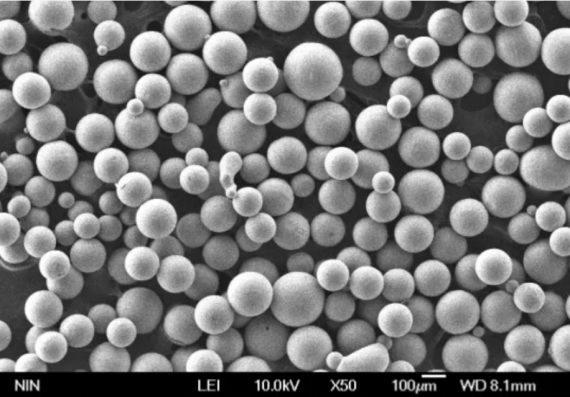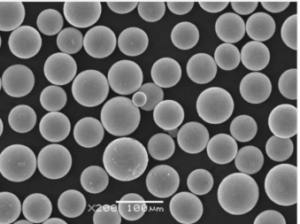نظرة عامة على ترسيب المعدن المصهور (MMD)
ترسيب المعادن المنصهرة (MMD) هي تقنية تصنيع إضافية متطورة تستخدم لإنشاء أجزاء معدنية معقدة وعالية الأداء. تتضمن هذه العملية ترسيب طبقات من المعدن المصهور لبناء مكون من الصفر، مما يوفر دقة وقوة لا مثيل لهما. تحظى MMD بتقدير خاص في صناعات مثل الفضاء والسيارات والطبية، حيث يزداد الطلب على المكونات المعقدة والقوية.
في هذا الدليل، سوف نتعمق في تفاصيل MMD، بما في ذلك أنواع المساحيق المعدنية المستخدمة وخصائصها وتطبيقاتها والمزيد. في النهاية، سيكون لديك فهم شامل لسبب قيام MMD بإحداث ثورة في التصنيع وكيف يمكن تطبيقه في مختلف الصناعات.

أنواع المساحيق المعدنية المستخدمة في MMD
يعد فهم المساحيق المعدنية المختلفة المستخدمة في MMD أمرًا بالغ الأهمية لاختيار المادة المناسبة لتطبيقات معينة. فيما يلي نظرة عامة مفصلة على عشرة نماذج مسحوق معدني محددة شائعة الاستخدام في MMD، إلى جانب تركيباتها وخصائصها.
| نموذج المسحوق المعدني | التركيب | الخصائص | صفات |
|---|---|---|---|
| التيتانيوم Ti-6Al-4V | 90% التيتانيوم، 6% الألومنيوم، 4% الفاناديوم | نسبة عالية من القوة إلى الوزن ومقاومة التآكل | تستخدم على نطاق واسع في صناعة الطيران، متوافقة حيويًا للزرعات الطبية |
| فولاذ مقاوم للصدأ 316L | الحديد، الكروم، النيكل، النيكل، الموليبدينوم | مقاومة ممتازة للتآكل، صلابة عالية | مثالي للتطبيقات البحرية والطبية |
| الألومنيوم AlSi10Mg | الألومنيوم والسيليكون والمغنيسيوم | خفة الوزن وخصائص حرارية جيدة | مناسب لمكونات السيارات والفضاء |
| انكونيل 718 | النيكل والكروم والحديد والنيوبيوم | مقاومة عالية لدرجة الحرارة، مقاومة جيدة للأكسدة | تستخدم في التوربينات الغازية ومحركات الصواريخ |
| الكوبالت-الكروم | الكوبالت، الكروم | مقاومة عالية للتآكل والتآكل، متوافقة حيويًا | شائعة في زراعة الأسنان والعظام |
| فولاذ الأدوات H13 | الحديد، الكروم، الموليبدينوم، الموليبدينوم، الفاناديوم | صلابة وصلابة عالية | تستخدم في القوالب والقوالب لقولبة الحقن البلاستيكية |
| النحاس CuNi2SiCr | النحاس والنيكل والسيليكون والكروم | موصلية حرارية وكهربائية عالية | تستخدم في المكونات الكهربائية والمبادلات الحرارية |
| فولاذ مارينج (1.2709) | الحديد، والنيكل، والنيكل، والكوبالت، والموليبدينوم | قوة فائقة وصلابة جيدة | تستخدم في الأدوات والأجزاء عالية الأداء |
| سبيكة النيكل 625 | النيكل، والكروم، والموليبدينوم، والموليبدينوم، والنيوبيوم | مقاومة ممتازة للتآكل والأكسدة | مثالي للتطبيقات البحرية والمعالجة الكيميائية |
| البرونز CuSn10 | نحاس، قصدير | مقاومة جيدة للتآكل، سهولة الصب | تستخدم في المحامل والبطانات والمنحوتات الفنية |
تطبيقات ترسيب المعادن المنصهرة (MMD)
تجعل تعدد استخدامات MMD مناسبًا لمجموعة واسعة من التطبيقات. فيما يلي جدول يلخص التطبيقات المختلفة لـ MMD عبر الصناعات المختلفة.
| الصناعة | التطبيقات | المزايا |
|---|---|---|
| الفضاء | مكونات المحرك، الأجزاء الهيكلية | خفيف الوزن، قوة عالية، أشكال هندسية معقدة |
| السيارات | أجزاء المحرك، مكونات الهيكل | تحسين الأداء، تقليل الوزن، التصميمات المخصصة |
| الطبية | الغرسات والأدوات الجراحية | التوافق الحيوي، التخصيص، النماذج الأولية السريعة |
| البحرية | المراوح والمكونات الهيكلية | مقاومة التآكل والمتانة |
| الطاقة | شفرات التوربينات، والمبادلات الحرارية | مقاومة عالية لدرجة الحرارة، الكفاءة |
| الإلكترونيات | الموصلات، المشتتات الحرارية | توصيل عالي، دقة |
| الأدوات | القوالب، القوالب | قوة عالية، مقاومة التآكل، دقة |
| الفن والمجوهرات | المنحوتات والمجوهرات المخصصة | تصميمات معقدة، تنوع المواد |
| معدات صناعية | مكونات الآلة، التروس | المتانة، القوة، الحلول المخصصة |
| الإنشاءات | العناصر الهيكلية، السحابات | القوة، مقاومة التآكل، الأشكال المعقدة |
المواصفات والأحجام والدرجات والمعايير
لضمان الاتساق والجودة في MMD، يتم اتباع معايير وأحجام ودرجات معينة. يوضح الجدول أدناه هذه المواصفات.
| المواد | المواصفات | الأحجام (مم) | درجات | المعايير |
|---|---|---|---|---|
| التيتانيوم Ti-6Al-4V | أستم ب 348، أم أس 4911 | 1-50 | الصف الخامس | ASTM، AMS، ISO |
| فولاذ مقاوم للصدأ 316L | ASTM A240، AMS 5507 | 0.5-100 | درجة 316L | ASTM، AMS، ISO |
| الألومنيوم AlSi10Mg | إن 1706، أيزو 3522 | 0.5-50 | AlSi10 ملغ | EN، ISO |
| انكونيل 718 | AMS 5662، ASTM B637، AMS 5662، ASTM B637 | 1-50 | UNS N07718 | AMS، ASTM |
| الكوبالت-الكروم | astm f75، ISO 5832-4 | 1-20 | CoCrMo | ASTM، ISO |
| فولاذ الأدوات H13 | ASTM A681، SAE J437 | 1-100 | H13 | ASTM، SAE |
| النحاس CuNi2SiCr | DIN 17670، ASTM B505 | 0.5-100 | CuNiNi2SiCr | DIN، ASTM |
| فولاذ مارينج (1.2709) | AMS 6514، DIN 1.2709 | 1-50 | الصف 300 | AMS، DIN |
| سبيكة النيكل 625 | AMS 5599، ASTM B443 | 1-50 | UNS N06625 | AMS، ASTM |
| البرونز CuSn10 | ASTM B505، SAE J461 | 1-100 | النحاس 10 | ASTM، SAE |






تفاصيل الموردين والأسعار
يعد معرفة مكان الحصول على المساحيق المعدنية وتكلفتها أمرًا حيويًا للميزانية والتخطيط في MMD. إليك جدول به تفاصيل عن الموردين والتسعير.
| المورد | الموقع | المواد المتاحة | السعر (دولار/كجم) |
|---|---|---|---|
| EOS GmbH | ألمانيا | Ti-6Al-4V، 316L، AlSi10Mg، Inconel 718 | 150-400 |
| تكنولوجيا النجار | الولايات المتحدة الأمريكية | الكوبالت والكروم، H13، فولاذ ماراجينج | 200-500 |
| ساندفيك | السويد | 316L، CuNi2SiCr، Inconel 625 | 100-300 |
| AP&C | كندا | Ti-6Al-4V، 316L، AlSi10Mg | 180-350 |
| GKN Hoeganaes | الولايات المتحدة الأمريكية | البرونز CuSn10، 316L، فولاذ ماراجينج | 120-400 |
| براكسير | الولايات المتحدة الأمريكية | Ti-6Al-4V، 316L، Inconel 718، CuNi2SiCr | 200-450 |
| هوغاناس إيه بي | السويد | الفولاذ المقاوم للصدأ، الفولاذ الأدوات، البرونز | 150-400 |
| تقنية LPW | المملكة المتحدة | 316L، AlSi10Mg، Inconel 625 | 180-360 |
| أركام إيه بي | السويد | Ti-6Al-4V، CoCrMo، Inconel 718 | 250-500 |
| أنظمة تكنا بلازما تكنا | كندا | 316L، Ti-6Al-4V، Inconel 718 | 200-450 |
مزايا وقيود MMD
تأتي كل تقنية مع إيجابياتها وسلبياتها. إليك مقارنة تفصيلية لمزايا وقيود MMD.
| أسبكت | مزايا | محددات |
|---|---|---|
| الدقة | دقة عالية في إنشاء أشكال هندسية معقدة | يتطلب تحكمًا ومعايرة دقيقة |
| خواص المواد | خصائص ميكانيكية وأداء ممتازين | تقتصر على معادن وسبائك محددة |
| التخصيص | تصميمات قابلة للتخصيص بدرجة عالية | يمكن أن تزيد تعقيد التصميم من التكلفة والوقت |
| السرعة | إنتاج أسرع للكميات الصغيرة والمتوسطة | أبطأ للإنتاج على نطاق واسع |
| التكلفة | تقليل هدر المواد، فعال من حيث التكلفة للنماذج الأولية | استثمار أولي كبير في المعدات |
| القوة والمتانة | ينتج أجزاء قوية ومتينة | قد تتطلب بعض المواد معالجة لاحقة |
| الاستدامة | الحد الأدنى من النفايات، المواد القابلة لإعادة التدوير | عملية كثيفة الاستهلاك للطاقة |
| تعدد الاستخدامات | مجموعة واسعة من التطبيقات عبر الصناعات | غير مناسب لجميع أنواع المكونات |
| التكامل | يمكن دمجه مع عمليات التصنيع الأخرى | يتطلب معرفة ومهارات متخصصة |
| الابتكار | يتيح التصميمات المبتكرة والنماذج الأولية السريعة | يقتصر على التطورات التكنولوجية الحالية |
الخصائص الرئيسية لـ ترسيب المعادن المنصهرة (MMD)
دعنا نستكشف الخصائص الرئيسية لـ MMD التي تجعلها عملية تصنيع فريدة وقيّمة.
الدقة والدقة
إحدى الميزات البارزة لـ MMD هي دقتها. من خلال ترسيب المعدن المصهور طبقة تلو الأخرى، يمكن لـ MMD تحقيق تفاصيل معقدة قد تفوتها الطرق التقليدية. هذه الدرجة العالية من الدقة ضرورية للصناعات التي يمكن أن يؤدي فيها حتى أدنى انحراف إلى مشكلات كبيرة، مثل تطبيقات الفضاء أو التطبيقات الطبية.
تعدد استخدامات المواد
يتوافق MMD مع مجموعة متنوعة من المعادن والسبائك، كل منها يوفر خصائص فريدة. سواء كان ذلك هو نسبة القوة إلى الوزن العالية للتيتانيوم أو مقاومة التآكل الممتازة للفولاذ المقاوم للصدأ، يمكن لـ MMD تلبية الاحتياجات المتنوعة، مما يجعلها تقنية تصنيع متعددة الاستخدامات.
القوة والمتانة
تُعرف المكونات المنتجة من خلال MMD بقوتها ومتانتها الفائقة. هذا مفيد بشكل خاص في صناعات مثل السيارات والفضاء، حيث تخضع الأجزاء لظروف قاسية ويجب أن تحافظ على سلامتها بمرور الوقت.
التخصيص والمرونة
يسمح MMD بتخصيص كبير، مما يمكّن الشركات المصنعة من إنتاج أجزاء مصممة خصيصًا لمتطلبات محددة. هذه المرونة لا تقدر بثمن في التطبيقات التي تكون فيها الحلول المصممة حسب الطلب ضرورية، مثل الزرعات الطبية المخصصة أو مكونات الفضاء المتخصصة.
الكفاءة والاستدامة
MMD هي عملية فعالة تقلل من النفايات، لأنها تستخدم فقط المادة اللازمة لإنشاء الجزء. بالإضافة إلى ذلك، فإن العديد من المواد المستخدمة في MMD قابلة لإعادة التدوير، مما يساهم في استدامة عملية التصنيع.

التعليمات
ما هو ترسيب المعدن المصهور (MMD)؟
س: ما هو بالضبط ترسيب المعدن المصهور (MMD)؟
ج: ترسيب المعدن المصهور (MMD) هو عملية تصنيع إضافية تقوم ببناء أجزاء معدنية طبقة تلو الأخرى باستخدام المعدن المصهور. يسمح بأشكال هندسية دقيقة ومعقدة ومكونات عالية الأداء.
كيف تقارن طريقة الترسيب المعدني المصهور (MMD) بطرق التصنيع الإضافي الأخرى؟
س: كيف تختلف طريقة الترسيب المعدني المصهور (MMD) عن تقنيات الطباعة ثلاثية الأبعاد الأخرى؟
ج: على عكس طرق التصنيع الإضافي الأخرى التي قد تستخدم البلاستيك أو الراتنج، تستخدم طريقة الترسيب المعدني المصهور (MMD) المعدن، مما يوفر قوة ومتانة فائقتين. وهي مفيدة بشكل خاص للتطبيقات التي تتطلب أجزاء معدنية عالية الأداء.
ما هي المواد التي يمكن استخدامها في طريقة الترسيب المعدني المصهور (MMD)؟
س: ما هي أنواع المعادن والسبائك المستخدمة بشكل شائع في طريقة الترسيب المعدني المصهور (MMD)؟
ج: تشمل المعادن الشائعة المستخدمة في طريقة الترسيب المعدني المصهور (MMD) التيتانيوم Ti-6Al-4V، والفولاذ المقاوم للصدأ 316L، والألومنيوم AlSi10Mg، و Inconel 718، و Cobalt-Chrome، من بين أمور أخرى. تقدم كل مادة خصائص فريدة مناسبة لتطبيقات مختلفة.
ما هي فوائد استخدام طريقة الترسيب المعدني المصهور (MMD)؟
س: لماذا يجب أن أفكر في استخدام طريقة الترسيب المعدني المصهور (MMD) في التصنيع؟
ج: توفر طريقة الترسيب المعدني المصهور (MMD) دقة عالية، وخصائص مادية ممتازة، وتخصيصًا، وكفاءة، واستدامة. وهي مفيدة بشكل خاص لإنتاج أجزاء معقدة وعالية الأداء.
هل هناك قيود على تقنية MMD؟
س: ما هي عيوب أو قيود تقنية MMD؟
ج: على الرغم من أن تقنية MMD متعددة الاستخدامات ودقيقة للغاية، إلا أنها قد تكون مكلفة من حيث الإعداد وتتطلب معرفة متخصصة. بالإضافة إلى ذلك، قد لا تكون مناسبة لجميع أنواع المكونات، وقد تحتاج بعض المواد إلى معالجة لاحقة.
كيف يمكنني البدء في استخدام تقنية MMD؟
س: ما الذي أحتاجه للبدء في استخدام تقنية MMD لمشروعاتي؟
ج: للبدء في استخدام تقنية MMD، ستحتاج إلى الوصول إلى آلة MMD، ومساحيق المعادن المناسبة، ومعرفة بالعملية. يمكن أن يساعدك التعاون مع الموردين والمصنعين ذوي الخبرة أيضًا في تبسيط اعتماد تقنية MMD.
من أين يمكنني الحصول على مساحيق المعادن لتقنية MMD؟
س: من أين يمكنني شراء مساحيق المعادن لتقنية MMD، وما الذي يجب أن أضعه في اعتباري؟
ج: يمكن الحصول على مساحيق المعادن لتقنية MMD من موردين مثل EOS GmbH و Carpenter Technology و Sandvik. ضع في اعتبارك عوامل مثل خصائص المواد والتكلفة وموثوقية المورد عند اتخاذ قرارك.

